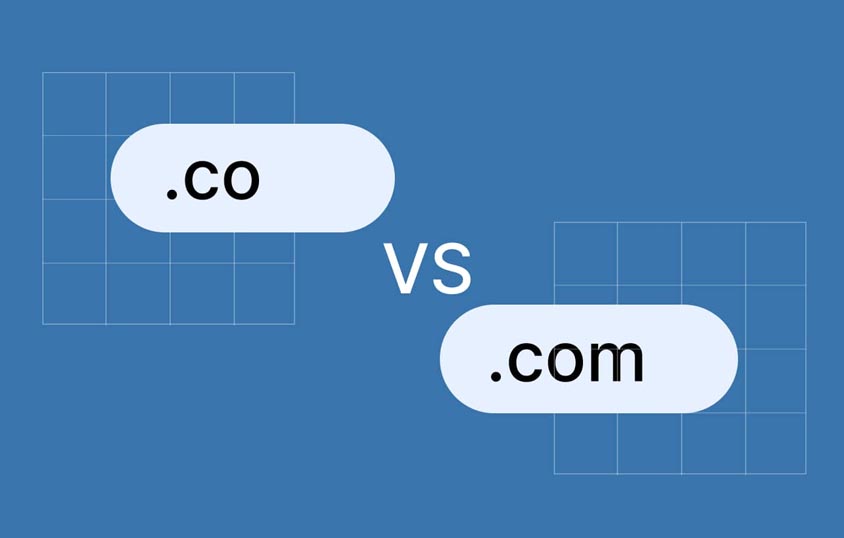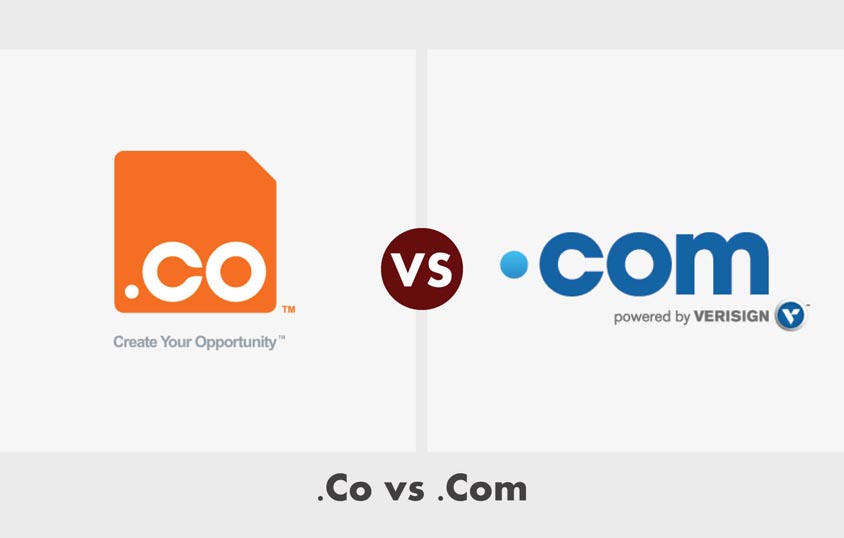Content
Recent Posts
.co vs .com: Which Domain Should You Pick in 2025?
![.co vs .com: Which Domain Should You Pick in [y]?](/_next/static/media/placeHolder844x538.62910306.png)
A domain name is the cornerstone of your online identity. It’s how people find you, remember you, and decide whether to trust your business. While social media and marketplaces give visibility, your domain remains something you truly control.
Among today’s many domain extensions, .com and .co stand out for their widespread use and visual similarity. At first glance, they look almost identical, yet they differ in history, pricing, and reputation.
In 2025, this choice matters more than ever. With .com names harder to find and .co gaining traction among startups, the question isn’t just about what’s available; it’s also about what best represents your brand’s credibility and direction.
Content
Understanding .co & .com
The .com extension, launched in 1985, remains the world’s most recognizable top-level domain (TLD). It started as a commercial identifier but now covers everything from personal blogs to global enterprises.
The .co extension began as Colombia’s country code but has grown into a globally marketed alternative. Today, Google treats it as a generic top-level domain (gTLD), not a country-specific one. Its short form and modern appeal have made it popular among startups and creative ventures seeking memorable, one-word names that are long gone in .com.
As of early 2025, .com holds more than 157 million active registrations, while .co has around 3 million. In June 2025, registry operations for .co shifted from GoDaddy Registry to Team Internet, ensuring continued reliability and updated management.

Availability
After nearly four decades, most short and simple .com names are already taken. Desirable one-word or brandable domains often sell for steep prices on secondary markets. Even smaller businesses face challenges in finding available names that match their brand.
The .co extension remains much more open. You’re far more likely to secure a concise and creative name without relying on hyphens or obscure spellings. That availability is one reason .co appeals to startups, independent creators, and tech brands.
However, the visual similarity between .co and .com can cause confusion. Users sometimes type “.com” by habit or send emails to the wrong address. To protect your brand, it’s wise to register both extensions if possible and redirect one to the other.
If memorability and flexibility matter most, .co gives you more options. If minimizing confusion and reinforcing familiarity are priorities, .com remains the safer pick.
SEO & Google Ranking
When it comes to search performance, both extensions are equal. Google has stated that all gTLDs are treated the same in ranking algorithms. Therefore, your choice between .co and .com won’t directly affect your SEO.
The deciding factors lie elsewhere, such as your website’s content, backlinks, and user engagement. Still, user perception can create small indirect differences. Since .com feels more familiar, users might be more inclined to click on it, leading to slightly higher clickthrough rates.
In practice, if your .co website provides strong value and consistent branding, it can rank just as well as any .com site. The quality of your work, not the letters at the end of your domain, determines your visibility.
Popularity & Recognition
.com continues to dominate the internet landscape. According to Verisign’s 2025 data, it represents more than 40% of all domain registrations worldwide. This deep familiarity gives .com an unmatched level of trust as people see it and instantly associate it with legitimacy.
Meanwhile, .co has built its own following, especially among new businesses and creative agencies. It’s viewed as modern and bold, giving brands a way to stand out when .com names aren’t available. The extension has been adopted by companies such as BRIT+CO (brit.co) and 500 Global (500.co), showing that it can carry serious professional weight.
Still, .com’s universal recognition gives it an edge for businesses serving a broad or traditional audience. If your brand leans toward innovation or startup culture, .co offers a modern twist without sacrificing professionalism.

Pricing & Renewals
The pricing gap between .com and .co remains significant.
.com domains, managed by Verisign, hold a fixed wholesale price of $10.26 per year through 2026. Most registrars charge around $12–$20 annually to customers, with consistent renewal costs.
.co domains cost more. After GoDaddy’s April 2025 adjustment, the wholesale price rose to $26 per year, and retail prices typically range from $25 to $40 annually. Many registrars promote lower first-year rates to attract new customers, but renewals climb sharply afterward.
Over time, these higher renewal fees add up. For long-term use, .com offers better affordability and predictability. But if branding flexibility is more valuable than cost, .co may justify the investment.
Trust & Brand Credibility
Trust plays a big role in how people perceive your website. The .com extension benefits from decades of recognition. It appears credible by default, which can improve how potential customers view your business.
The .co extension has earned legitimacy but still feels niche to some audiences. It works best for industries that value originality, such as design, software, or media. Brands using .co often project confidence, signaling that they’re fresh and forward-thinking.
For companies in sectors like finance, healthcare, or retail, .com remains the more reassuring choice. But for startups or creative brands, .co can add a sense of personality without hurting credibility.
Security & Technical Reliability
Both .com and .co meet international security standards under ICANN’s registry policies. They support SSL certificates, DNSSEC, and other protective technologies equally well.
Verisign, which operates .com, is recognized for maintaining 100% operational accuracy and availability for its domain resolution services since 1997, according to its long-standing company performance reports. Team Internet, which assumed control of .co in 2025, follows the same DNS and infrastructure reliability frameworks.
From a technical standpoint, both extensions perform on par. Your choice of hosting provider will have a much greater impact on website performance and security than the domain extension itself.

Top Domain Registrars for .co & .com
When registering either extension, choosing a reliable registrar is just as important as picking the right TLD. In 2025, the most popular and trusted registrars for .com and .co include:
GoDaddy — One of the world’s largest registrars, offering user-friendly tools, 24/7 support, and competitive pricing. They handle millions of .com registrations and continue to promote .co domains with marketing campaigns for startups.
Namecheap — Known for transparency and affordable renewals. Namecheap offers strong domain management features and frequent promotional pricing, making it a top choice for small businesses and developers.
Google Domains — Recently integrated into Google’s broader ecosystem, it’s a convenient choice for users already using Google Workspace or Ads. It provides reliable DNS performance, automatic security, and simple integration.
All three registrars sell both .co and .com, often with first-year discounts. The best pick depends on your needs: Namecheap for value, GoDaddy for scale, or Google Domains for simplicity.
Which Extension Fits You Best?
Both .co and .com have strengths, but they serve different needs.
If you want familiarity, cost-efficiency, and global recognition, .com is the clear winner. It reinforces trust and ensures fewer user errors when typing or sharing your site.
If you want availability, modern appeal, and short, brandable options, .co shines. It lets you secure a creative name without competing for limited .com inventory, making it ideal for startups and tech-focused ventures.
Your decision depends on how you want your brand perceived. Established companies often benefit more from .com’s authority, while innovative or emerging brands can use .co to signal modernity and distinctiveness.
Final Thoughts
Both .co and .com are secure, SEO-friendly, and reliable. The right choice depends on your audience and goals.
If your priority is affordability and universal trust, choose .com. If you want originality and availability, .co offers flexibility, just prepare for higher renewal costs and consider securing the .com variant for protection.
Your domain isn’t just an address; it’s a branding decision that affects visibility, trust, and perception. Think long-term, review renewal rates, and choose the extension that aligns with your story in 2025 and beyond. After buying a .com domain name, the next steps typically include choosing a hosting provider, connecting your domain name to your website, setting up professional email addresses, and configuring security features like SSL certificates. These actions ensure your domain is active, secure, and ready to enhance your online visibility. For a broader look at what’s available, explore our full reviews in the web hosting services category, use our comparison tool to view top choices side by side, and browse our educational articles for deeper insights into features and pricing.
Frequently Asked Questions
Does Google rank .com higher than .co?
No. Google treats all generic domains equally. Your rankings depend on site quality and backlinks, not the domain ending.
Is .co considered a country domain?
It originally represented Colombia but is now recognized globally as a generic extension.
Are .co domains more expensive?
Yes. .co renewals typically cost two to three times more than .com.
Can I use both .co and .com?
Yes. Registering both versions helps you protect your brand and redirect traffic.
Which extension works best for startups?
Startups often pick .co for shorter, brandable names, but .com still offers more long-term credibility for broader audiences.